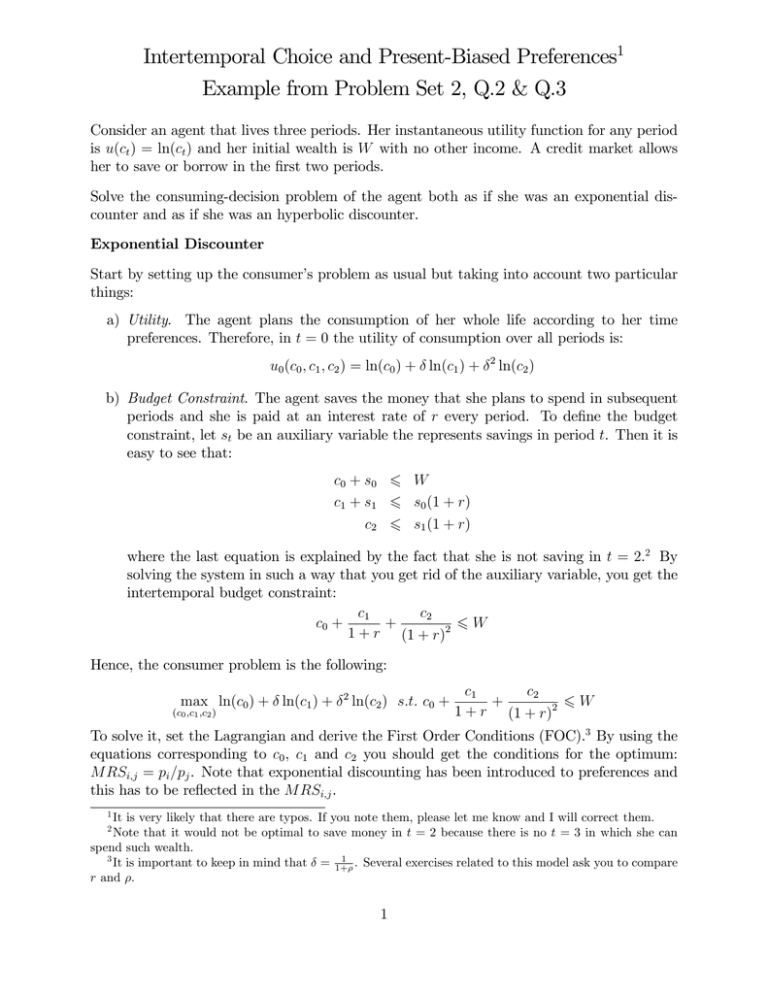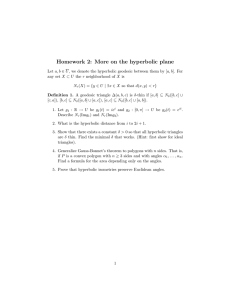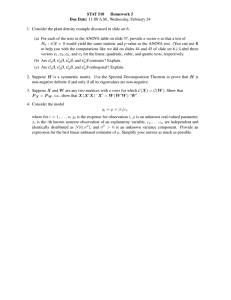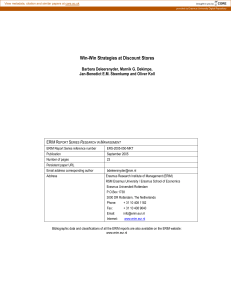Intertemporal Choice and Present-Biased Preferences
advertisement

Intertemporal Choice and Present-Biased Preferences1 Example from Problem Set 2, Q.2 & Q.3 Consider an agent that lives three periods. Her instantaneous utility function for any period is u(ct ) = ln(ct ) and her initial wealth is W with no other income. A credit market allows her to save or borrow in the …rst two periods. Solve the consuming-decision problem of the agent both as if she was an exponential discounter and as if she was an hyperbolic discounter. Exponential Discounter Start by setting up the consumer’s problem as usual but taking into account two particular things: a) Utility. The agent plans the consumption of her whole life according to her time preferences. Therefore, in t = 0 the utility of consumption over all periods is: u0 (c0 ; c1 ; c2 ) = ln(c0 ) + ln(c1 ) + 2 ln(c2 ) b) Budget Constraint. The agent saves the money that she plans to spend in subsequent periods and she is paid at an interest rate of r every period. To de…ne the budget constraint, let st be an auxiliary variable the represents savings in period t. Then it is easy to see that: c 0 + s0 6 W c1 + s1 6 s0 (1 + r) c2 6 s1 (1 + r) where the last equation is explained by the fact that she is not saving in t = 2.2 By solving the system in such a way that you get rid of the auxiliary variable, you get the intertemporal budget constraint: c2 c1 6W + c0 + 1 + r (1 + r)2 Hence, the consumer problem is the following: c1 c2 + 6W (c0 ;c1 ;c2 ) 1 + r (1 + r)2 To solve it, set the Lagrangian and derive the First Order Conditions (FOC).3 By using the equations corresponding to c0 , c1 and c2 you should get the conditions for the optimum: M RSi;j = pi =pj . Note that exponential discounting has been introduced to preferences and this has to be re‡ected in the M RSi;j . max ln(c0 ) + ln(c1 ) + 2 ln(c2 ) s:t: c0 + 1 It is very likely that there are typos. If you note them, please let me know and I will correct them. Note that it would not be optimal to save money in t = 2 because there is no t = 3 in which she can spend such wealth. 3 It is important to keep in mind that = 1+1 . Several exercises related to this model ask you to compare r and . 2 1 Trick 1: In interior solutions the condition MRS i;j =p i /p j always holds. Hence, you do not need to derive the FOC (at least you are explicitly asked to do so). This equality and the budget constraint are su¢ cient to …nd c . Note that although the story changes, this is a problem like the ones we have seen before. We need to derive the planned demand for three periods (before they were goods) as a function of income W and prices p0 = 1, p1 = 1= (1 + r) and p2 = 1= (1 + r)2 . In our exercise, the conditions read: u00 p0 c01 = ) = (1 + r) ) c01 = (1 + r)c0 u01 p1 c0 u00 p0 c02 = ) = (1 + r)2 ) c02 = 2 (1 + r)2 c0 2 0 2 p2 u2 c0 Trick 2: So far we had solved problems for the demands of two goods (now periods). Now there are three. Either if you solve the system of FOCs or you use Trick 1 to derive the optimal conditions, I suggest you to take one good (for instance demand in t = 0) as a reference and de…ne the conditions w.r.t. this. Then, by plugging the two conditions in the budget constraint you should obtain the demand for the reference good (period): W c0 = 1+ + 2 Finally, you can use c0 and the optimal conditions to derive the demands for periods 1 and 2: W (1 + r) W (1 + r)2 2 0 c01 = and c = 2 1+ + 2 1+ + 2 Hyperbolic Discounter Introduce the hyperbolic discounting in the utility function so that the problem now looks as follows: max ln(c0 ) + (c0 ;c1 ;c2 ) ln(c1 ) + 2 ln(c2 ) s:t: c0 + c1 c2 + 6W 1 + r (1 + r)2 Follow the procedure explained above. You should get the following demand functions c0 = W 1+ + 2 , c01 = W (1 + r) 1+ + 2 and c02 = W (1 + r)2 1+ + 2 2 Comparison: Exponential Discounter versus Hyperbolic Discounter - Exponential discounters are time consistent. It means that the consumption in each period is the one that has been planned beforehand, in the past. In our exercise this implies that c01 = c11 and c02 = c12 = c22 . 2 - Hyperbolic discounters are time inconsistent. It means that, with the simple set up and tools the we are given in this exercise, the agent is not able to meet her consumption plans.4 Finally, use subindex e and h for exponential discounters and hyperbolic discounters respectively. You can check yourself using the results above that: c00e < c00h ; c01h < c01e ; c02h < c02e Notice that regardless of the time consistency, the hyperbolic discounter is consuming more in the present (t = 0) and plans to consume less in the future. This is because it has a stronger present-biased preference. 4 Lecture notes explain re…nements such as the di¤erentiation between sophisticated and naive agents or the introduction of commitment devices 3




